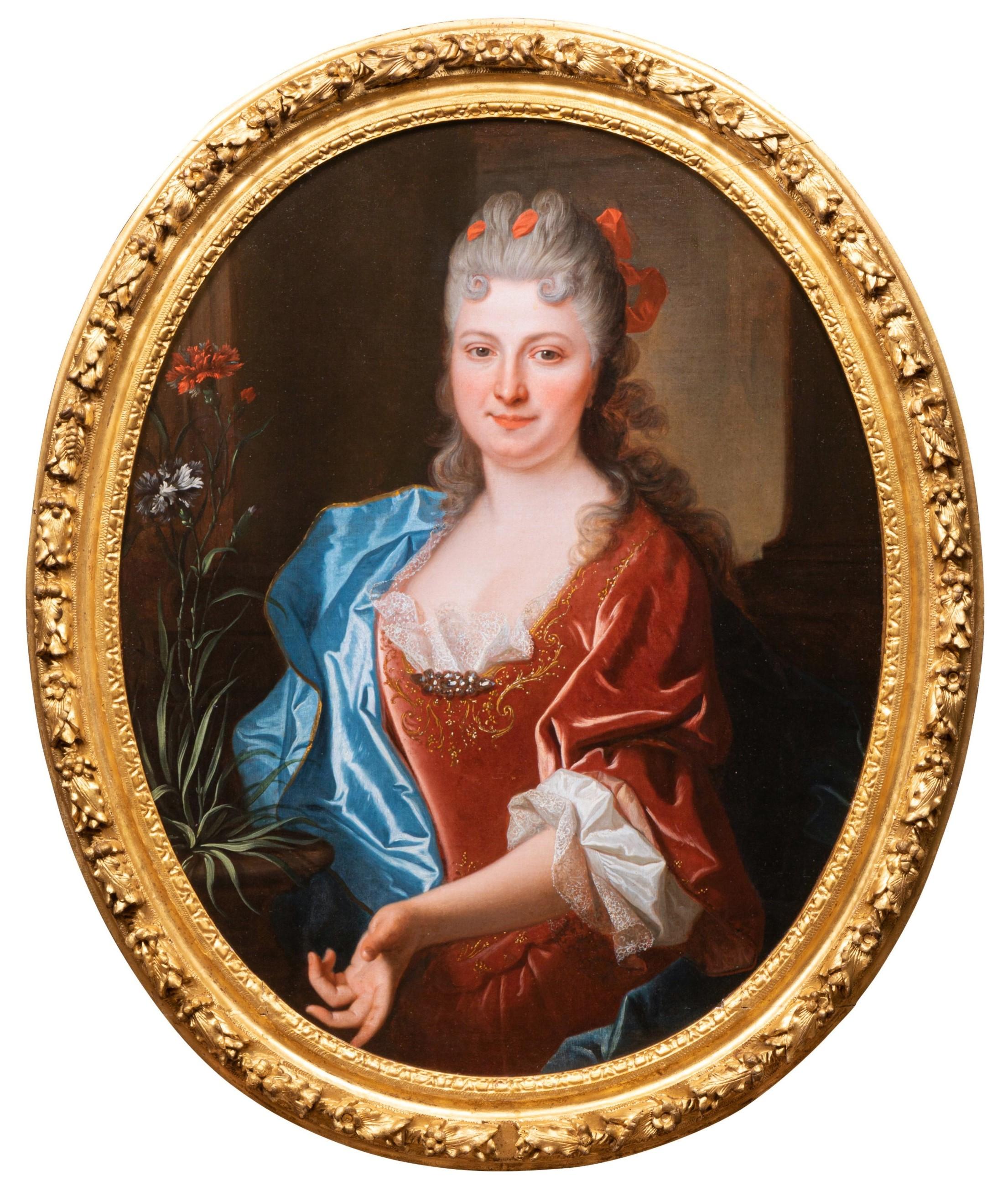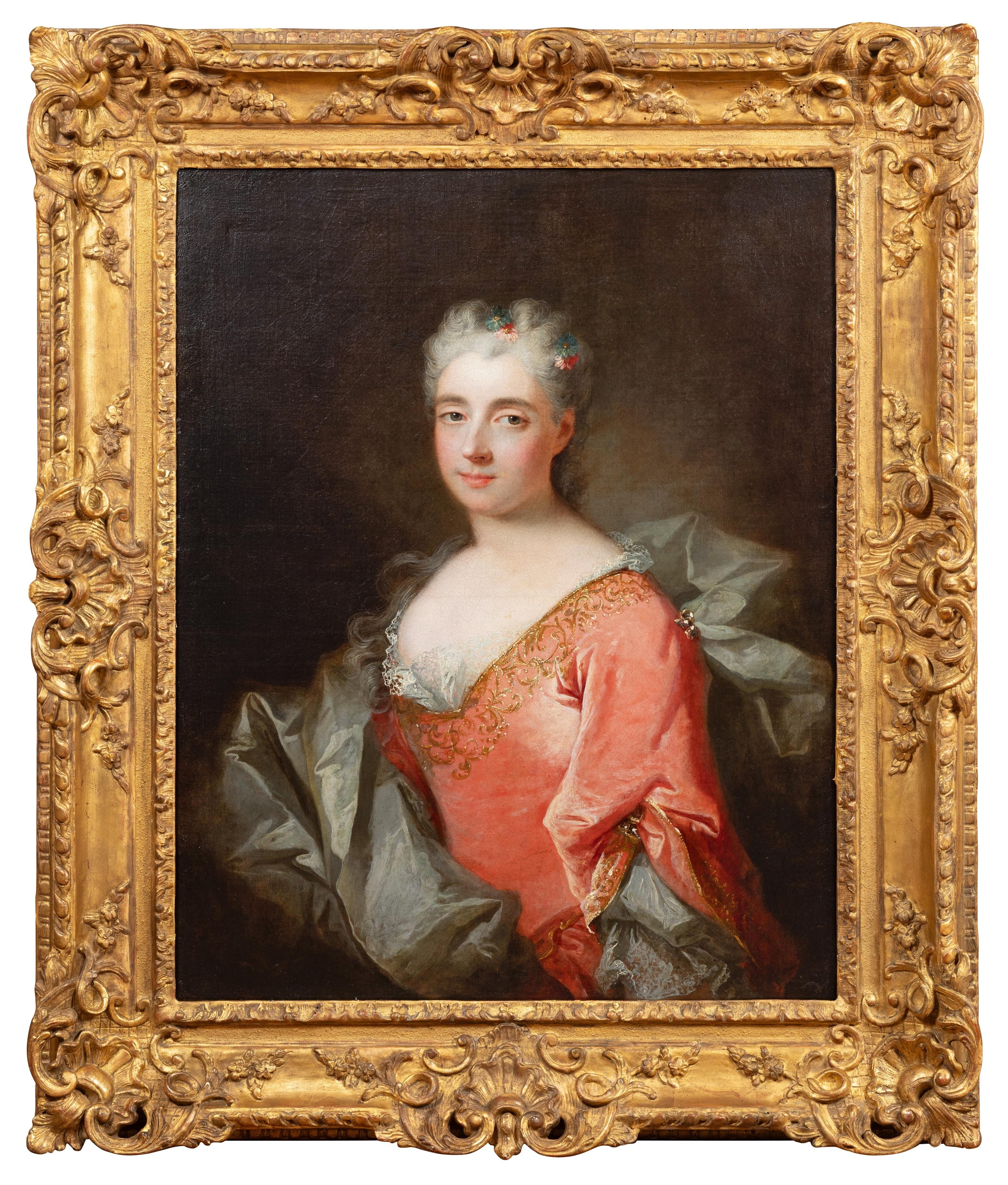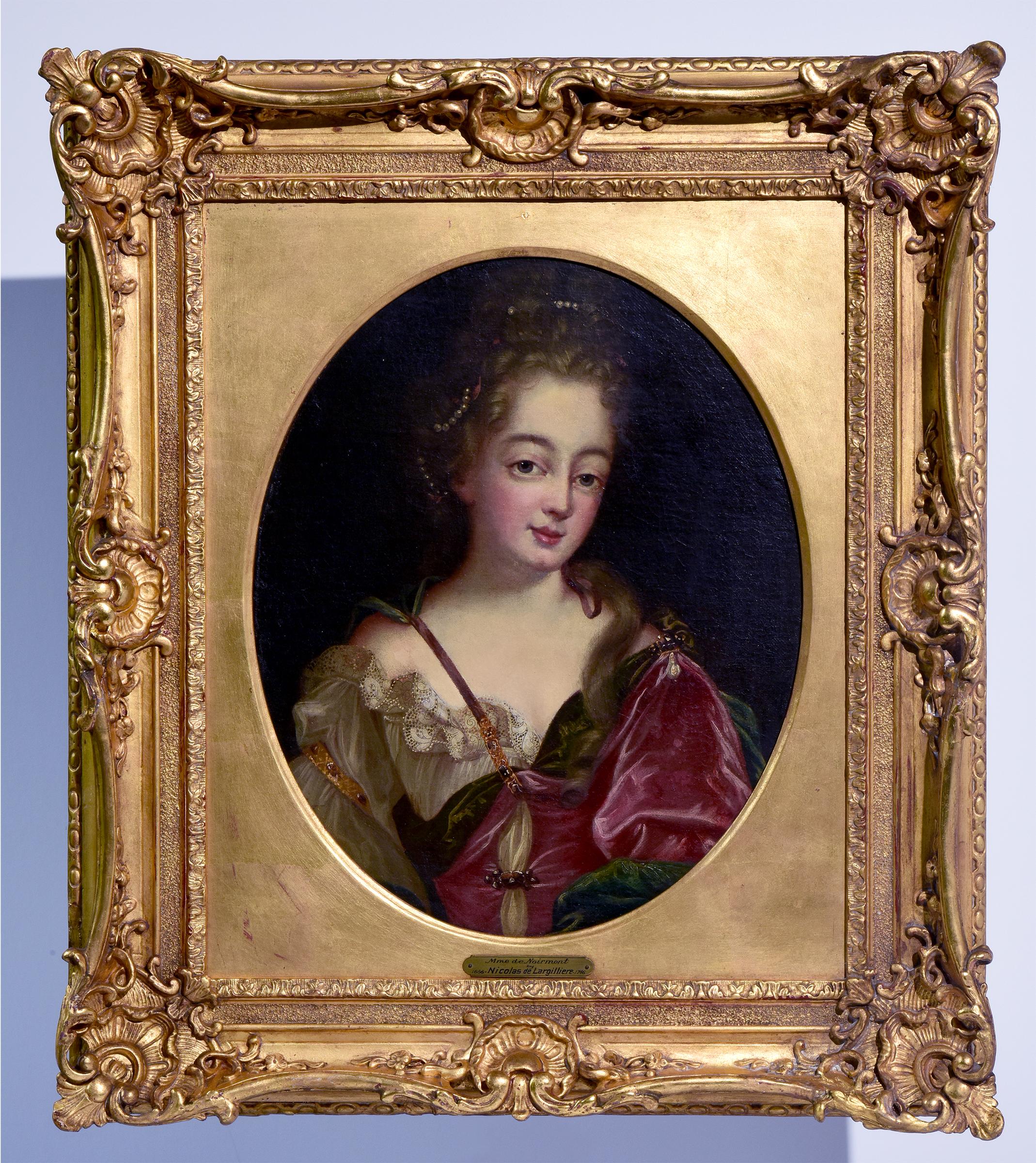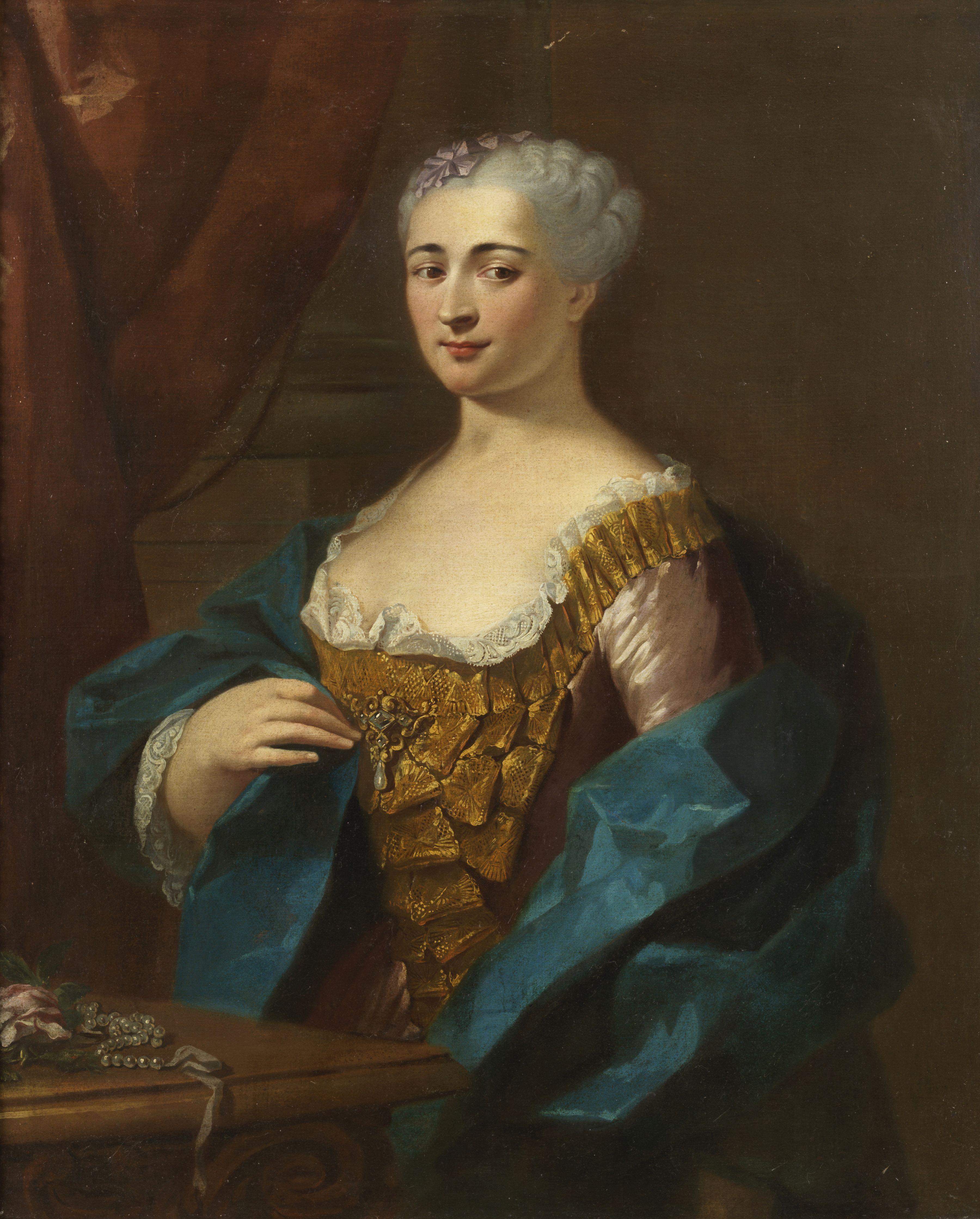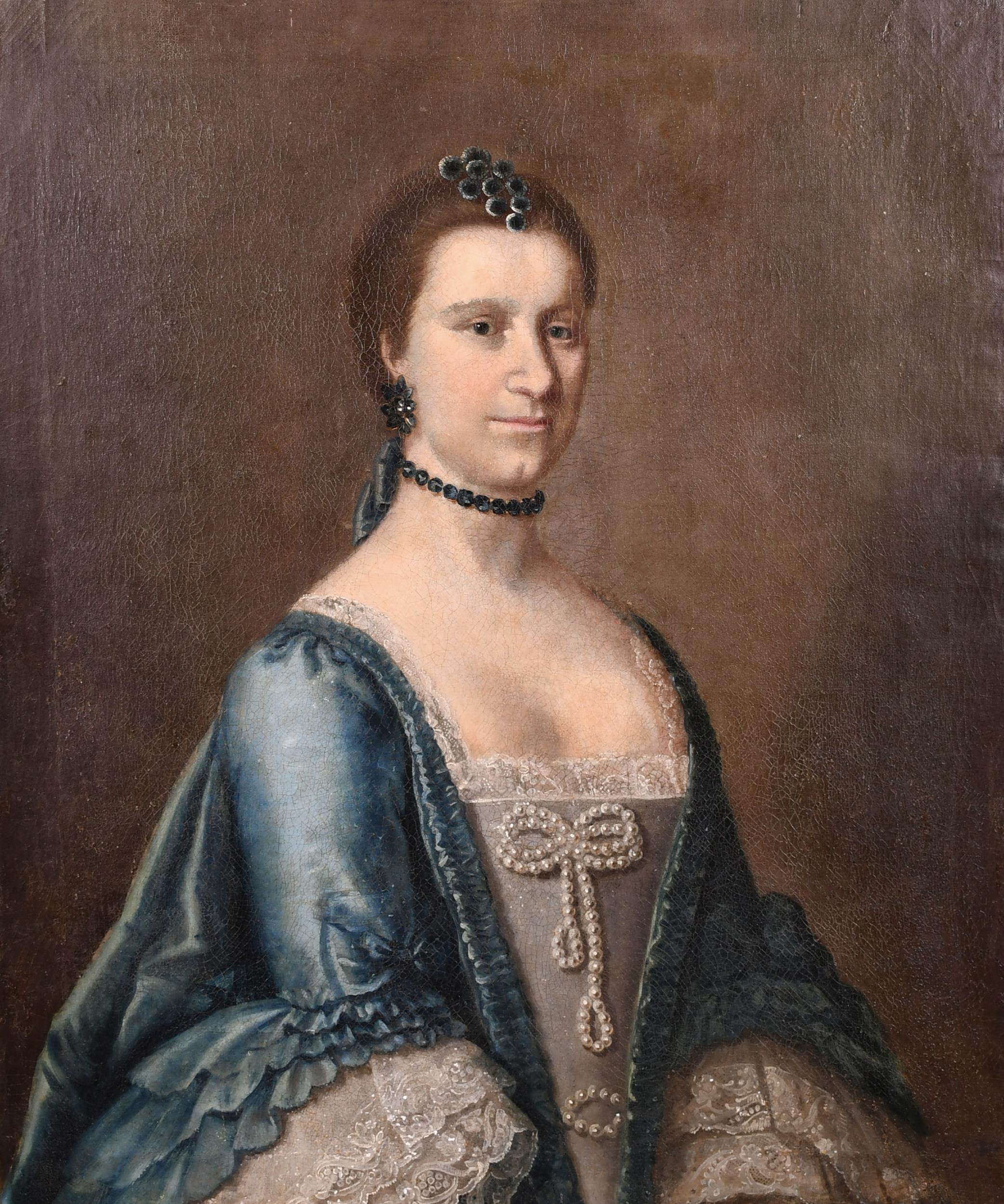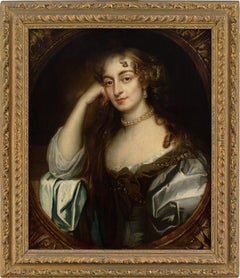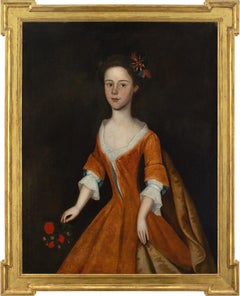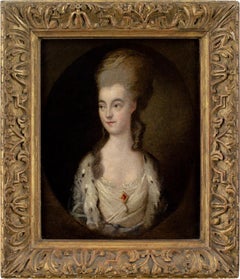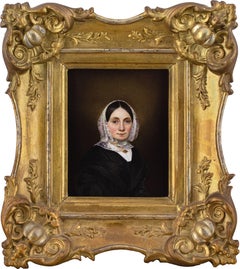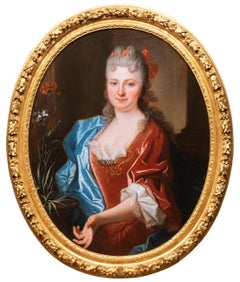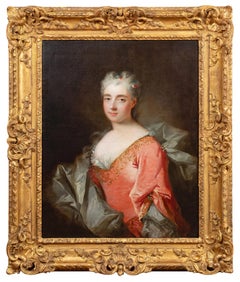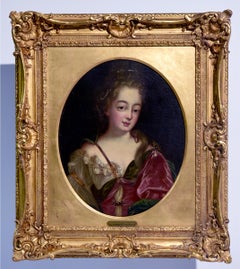Items Similar to Mid-18th-Century French School, Portrait Of A Lady With Sapphires
Want more images or videos?
Request additional images or videos from the seller
1 of 13
UnknownMid-18th-Century French School, Portrait Of A Lady With Sapphiresc. 1740
c. 1740
$2,737.61
£1,980
€2,334.81
CA$3,789.79
A$4,109.24
CHF 2,180.72
MX$50,610.50
NOK 27,028.71
SEK 25,508.89
DKK 17,427.61
About the Item
This charming mid-18th-century half-length French portrait depicts a lady wearing an olive green gown, together with a red cloak, and exquisite sapphire jewellery.
Painted circa 1740, this piece can be contextualised by considering Louis Tocqué’s (1696-1772) portrait of Marie Leczinska, Queen of France, as Royal commissions often set the bar in terms of fashion. Note the similarities of the neckline, use of jewellery, and hairstyle, with its single curl resting upon the left shoulder.
The inclusion of blue sapphires is a particularly interesting one as these were a prized possession and demonstrated one’s wealth, taste and loyalty in equal measure. During the 18th century, they were celebrated for their 'magical' properties, which protected against evil. With some believing they would change colour if the wearer lacked virtue. Evidently, our lady is a god-fearing exemplar of sound judgment.
Once upon a time, this portrait probably hung within a palatial setting decorated with ornate Rococo furnishings. It was a period of ostentatious displays, gilt everything, and sumptuous curves - distinctly more elegant when compared to the drama and pomp of the Baroque period. Its key tenets were the pursuit of happiness, frivolity, beauty, and, ultimately, l’amour.
Unsigned and held in a later frame.
Medium: Oil on canvas
Year of creation: c. 1740
Provenance: Private collection, Italy.
- Creation Year:c. 1740
- Dimensions:Height: 39 in (99.06 cm)Width: 34 in (86.36 cm)Depth: 2 in (5.08 cm)
- Medium:
- Movement & Style:
- Period:
- Condition:Cleaned. Revarnished. Canvas relined. Later stretcher. Faint stretcher mark. Areas of fine and settled craquelure, as you would expect. The paint layer is stable. Frame in good condition with minor age-related wear.
- Gallery Location:Cheltenham, GB
- Reference Number:1stDibs: LU2328216475462
About the Seller
5.0
Platinum Seller
Premium sellers with a 4.7+ rating and 24-hour response times
Established in 2017
1stDibs seller since 2023
244 sales on 1stDibs
Typical response time: <1 hour
- ShippingRetrieving quote...Shipping from: Cheltenham, United Kingdom
- Return Policy
Authenticity Guarantee
In the unlikely event there’s an issue with an item’s authenticity, contact us within 1 year for a full refund. DetailsMoney-Back Guarantee
If your item is not as described, is damaged in transit, or does not arrive, contact us within 7 days for a full refund. Details24-Hour Cancellation
You have a 24-hour grace period in which to reconsider your purchase, with no questions asked.Vetted Professional Sellers
Our world-class sellers must adhere to strict standards for service and quality, maintaining the integrity of our listings.Price-Match Guarantee
If you find that a seller listed the same item for a lower price elsewhere, we’ll match it.Trusted Global Delivery
Our best-in-class carrier network provides specialized shipping options worldwide, including custom delivery.More From This Seller
View AllJacob Huysmans (Attributed), Portrait Of A Lady With Pearls
By Jacob Huysmans
Located in Cheltenham, GB
This splendid mid-17th-century half-length portrait attributed to Flemish artist, Jacob Huysmans (c.1630-1696) depicts a lady wearing a brown and ivory dress decorated with pearls, t...
Category
Mid-17th Century Baroque Portrait Paintings
Materials
Canvas, Oil
Mid-18th-Century English School, Portrait Of A Girl With A Posy
Located in Cheltenham, GB
This exceedingly charming mid-18th-century English oil painting depicts a girl wearing a red gown with a train over a white petticoat. She’s holding a posy or nosegay.
Evidently once commissioned for an English country house, the identity of this young lady remains a mystery. Her gown appears to be inspired by the popular ‘robe à la française...
Category
1740s English School Portrait Paintings
Materials
Oil, Canvas
Thomas Gainsborough (Follower), Portrait Of Miss Sparrow
By Thomas Gainsborough
Located in Cheltenham, GB
This exceedingly charming early 19th-century half-length portrait by a follower of Thomas Gainsborough RA FRSA (1727-1788) depicts a lady traditionally identified as ‘Miss Sparrow’. ...
Category
1830s Portrait Paintings
Materials
Oil, Canvas
Mid-19th-Century German School, Portrait Of A Woman
Located in Cheltenham, GB
This fine mid-19th-century German miniature depicts a woman wearing a black dress and a beautiful white and lilac day cap.
Produced around 1840, this exquisite piece on porcelain is...
Category
1840s Victorian Portrait Paintings
Materials
Porcelain
John Verelst (Circle), Portrait Of A Young Lady With A Spaniel
By John Verelst
Located in Cheltenham, GB
This large early 18th-century full-length portrait depicts a seated young lady before a classical column and distant country house. It was formerly in the collection of Dalham Hall i...
Category
Early 18th Century Rococo Portrait Paintings
Materials
Canvas, Oil
Jean Baptiste Discart, Portrait Of A Lady With A Yellow Rose
Located in Cheltenham, GB
This fine late 19th-century portrait by renowned Italian artist Jean Baptiste Discart (1856-1944) depicts a lady wearing a black dress embellished with a lace collar, together with a single yellow rose. It’s catalogued (#3) in Theo P.G. Kralt’s book, Jean Baptiste Discart, Orientalist Paintings and Dutch Portraits.
A provocative rose draws one’s eye to the ‘décolletage’. Was it her idea or the bold suggestion of a young Discart, just 21, and bursting with energy? The style of dress came to the fore during the late 19th century and was regarded as somewhat improper by a stoic older generation. But, of course, the glaring eyes only encouraged young ladies to rebel and adopt the fashion regardless.
Little is known about the sitter, but it’s conceivable that she’s either Austrian or French, given Discart’s known locations in 1879. It was completed during his training. It bears all the hallmarks of a young and confident painter looking to establish himself.
Born in Modena, Italy, Discart’s father, Francesco Ferdinando, moved in particularly distinguished circles and worked for the Duke of Modena. Indeed, the Duke became young Jean’s godfather, so the pair were well-connected. One can only imagine the ostentatious interiors that he witnessed during childhood, and it’s conceivable that these experiences inspired his appreciation for the finer things in life.
At 14, he was enrolled at the Academy of Fine Arts in Vienna, where he trained under the German painter, Anselm Feuerbach (1829-1880). It seems that he stayed here until Feuerbach’s retirement in 1877 when the course was handed over to Leopold Carl Müller (1834-1892). His short time under Müller, known for his exquisite ‘orientalist’ work, would be transformative.
From here, he left Vienna to immerse himself in the cosmopolitan environs of the French Capital and exhibited at the Paris Salon in 1884. At that point in time, Paris was an exciting place for an emerging artist. In 1884, the Société des Artistes Indépendants held their first show, which included works by Paul Cézanne...
Category
Late 19th Century Victorian Portrait Paintings
Materials
Canvas, Oil
You May Also Like
18th c. French Portrait of a Lady by Jean Ranc (1674 - 1735), Paris circa 1700
Located in PARIS, FR
Portrait of a Lady with carnations
By Jean Ranc (Montpellier 1674 - Madrid 1735), circa 1700
Oil on canvas in oval shape,
Dimensions: h. 35.82, w. 28.34 in.
Period Louis XIV giltwood and carved frame with laurel leaves.
Framed dimensions: h. 42.52 in, w. 33.85 in.
Provenance: Collection of the Marquis de Bailleul at the Château d'Angerville-Bailleul (before 1942).
To be included in the catalog raisonné of the artist by Stephane Perreau
Important portrait of a young woman depicted half-length turned three-quarters, her face looking at the viewer.
Dressed in a brick red velvet dress, an elegant blue scarf envelops her figure.
Hair styled “a la Fontange”, her powdered hair is raised and tied at the back with a red ribbon, several curly locks escape from her bun and fall on her back and shoulders.
The perfectly oval face with regular features dominated by her straight nose is softened by her gray eyes with slightly lowered lids. The red tinged skin tones on the cheeks and cheekbones color the face and make the portrait come alive.
The young woman is portrayed standing near a pot of carnations. Her strongly lighted figure stands out against an architectural background of columns.
The artist's palette is made of contrasts opposing warm to cold hues. The icy electric blue contrasts with the fiery brick red, the hair powdered with white accentuates even more the flush of the cheeks.
The left arm bent at the elbow, extending the open hand with slightly bent fingers in the foreground brings depth to the composition.
Our portrait, an interesting testimony in the corpus of works of the painter, is part of his youthful period, around 1700-1705.
The former belonging of this portrait to the Marquis de Bailleul reinforces the remarkable character of our painting.
The portrait has been examined by Stéphane Perreau, specialist of Jean Ranc and will be included in the catalog raisonné currently being written, under number P. 43. The notice edited by Mr Perreau is below:
"Painted around 1700-1705, this portrait of a woman is directly inherited from Hyacinthe Rigaud, the master of Jean Ranc (the hand turned over the front, in a watch...
Category
Early 18th Century Old Masters Portrait Paintings
Materials
Canvas, Oil
Portrait of a French lady by Robert Le Vrac Tournieres, circa 1725
Located in PARIS, FR
Portrait of a young Lady
Robert Le Vrac Tournières (1667-1752)
18th century French school, circa 1725
Oil on canvas
Dimensions: h. 81 cm, w. 65 cm
Important 18th century Régence per...
Category
Early 18th Century Old Masters Portrait Paintings
Materials
Canvas, Oil
Attributed to MILLOT, Henri Portrait of a Lady
Located in Berlin, DE
Attributed to MILLOT, Henri. Portrait of a Lady. Oil on canvas. Unsigned, inscribed Millot on the reverse. 18th century. 85 x 69 cm. Framed. 85 x 69 cm. Portrait of a young woman in ...
Category
1720s Baroque Figurative Paintings
Materials
Oil
"Mme de Noirmont", Oil on Canvas Portrait, circa 18th Century
By (circle of) Nicolas de Largillierre
Located in Detroit, MI
This painting titled "Mme de Noirmont" is an oil on canvas work from the studio of Nicolas de Largilliere, one of the most prolific and esteemed French portrait painters of the 18th ...
Category
18th Century Portrait Paintings
Materials
Canvas, Adhesive, Oil
!8th Century Portrait of a Dame French School Woman Oil on Canvas Gold Blue
Located in Sanremo, IT
Painting oil on canvas measuring 92 x 75 cm without frame and 102 x 87 cm with frame depicting a rich lady of the French school of the first half of the 18th century.
In its formal ...
Category
Early 18th Century French School Portrait Paintings
Materials
Canvas, Oil
Large 18th Century English Oil Painting Portrait of Aristocratic Lady in Blue
Located in Cirencester, Gloucestershire
Portrait of a Noble Lady
English artist, mid 18th century
circle of Thomas Gainsborough (English 1727-1788)
oil on canvas, unframed
canvas: 30 x 25 inches
provenance: private collect...
Category
Mid-18th Century Old Masters Portrait Paintings
Materials
Oil, Canvas
More Ways To Browse
18th Century French Art
18th Century French Rococo Painting
18th French Oil Painting
Antique Amour
18th Century French Portraits
Queen Of France
Olive Green Gown
Oval Rococo Portrait
Portrait Habsburg
Princess Diana Painting
Procaccini Giulio Cesare
Robert Montgomery
Rosie Huntington Whiteley
Tarkay Oil Paintings
Tarkay Oil
Vintage Formula One Cars
Walter Stuempfig
Willem Wissing
